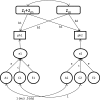Testing Causal Effects of Maternal Smoking During Pregnancy on Offspring's Externalizing and Internalizing Behavior
- PMID: 26324285
- PMCID: PMC4826626
- DOI: 10.1007/s10519-015-9738-2
Testing Causal Effects of Maternal Smoking During Pregnancy on Offspring's Externalizing and Internalizing Behavior
Abstract
Maternal smoking during pregnancy (SDP) is associated with increased risk of externalizing and internalizing behaviors in offspring. Two explanations (not mutually exclusive) for this association are direct causal effects of maternal SDP and the effects of genetic and environmental factors common to parents and offspring which increase smoking as well as problem behaviors. Here, we examined the associations between parental SDP and mother rated offspring externalizing and internalizing behaviors (rated by the Child Behavior Checklist/2-3) at age three in a population-based sample of Dutch twins (N = 15,228 pairs). First, as a greater effect of maternal than of paternal SDP is consistent with a causal effect of maternal SDP, we compared the effects of maternal and paternal SDP. Second, as a beneficial effect of quitting smoking before pregnancy is consistent with the causal effect, we compared the effects of SDP in mothers who quit smoking before pregnancy, and mothers who continued to smoke during pregnancy. All mothers were established smokers before their pregnancy. The results indicated a greater effect of maternal SDP, compared to paternal SDP, for externalizing, aggression, overactive and withdrawn behavior. Quitting smoking was associated with less externalizing, overactive behavior, aggression, and oppositional behavior, but had no effect on internalizing, anxious depression, or withdrawn behavior. We conclude that these results are consistent with a causal, but small, effect of smoking on externalizing problems at age 3. The results do not support a causal effect of maternal SDP on internalizing behaviors.
Keywords: Causality; Childhood behavioral problems; Parental prenatal smoking; Pleiotropic effects.
Figures

Similar articles
-
Smoking during pregnancy and offspring externalizing problems: an exploration of genetic and environmental confounds.Dev Psychopathol. 2008 Winter;20(1):139-64. doi: 10.1017/S0954579408000072. Dev Psychopathol. 2008. PMID: 18211732 Free PMC article.
-
Maternal smoking and child psychological problems: disentangling causal and noncausal effects.Pediatrics. 2010 Jul;126(1):e57-65. doi: 10.1542/peds.2009-2754. Epub 2010 Jun 29. Pediatrics. 2010. PMID: 20587678 Free PMC article.
-
Increase in child behavior problems resulting from maternal smoking during pregnancy.Arch Environ Health. 1997 Jul-Aug;52(4):317-21. doi: 10.1080/00039899709602205. Arch Environ Health. 1997. PMID: 9210734
-
Health outcomes of smoking during pregnancy and the postpartum period: an umbrella review.BMC Pregnancy Childbirth. 2021 Mar 26;21(1):254. doi: 10.1186/s12884-021-03729-1. BMC Pregnancy Childbirth. 2021. PMID: 33771100 Free PMC article.
-
Prenatal risk factors for internalizing and externalizing problems in childhood.World J Pediatr. 2020 Aug;16(4):341-355. doi: 10.1007/s12519-019-00319-2. Epub 2019 Oct 15. World J Pediatr. 2020. PMID: 31617077 Free PMC article. Review.
Cited by
-
The Effect of Smoking during Pregnancy on Severity and Directionality of Externalizing and Internalizing Symptoms: A Genetically Informed Approach.Int J Environ Res Public Health. 2020 Oct 28;17(21):7921. doi: 10.3390/ijerph17217921. Int J Environ Res Public Health. 2020. PMID: 33126697 Free PMC article.
-
Tobacco exposure and maternal psychopathology: Impact on toddler problem behavior.Neurotoxicol Teratol. 2016 Sep-Oct;57:87-94. doi: 10.1016/j.ntt.2016.07.003. Epub 2016 Aug 3. Neurotoxicol Teratol. 2016. PMID: 27498223 Free PMC article.
-
The Importance of the Prenatal Environment in Behavioral Genetics: Introduction to Special Issue.Behav Genet. 2016 May;46(3):281-5. doi: 10.1007/s10519-016-9790-6. Epub 2016 Apr 16. Behav Genet. 2016. PMID: 27085879 Free PMC article.
-
Multifaceted determinants of social-emotional problems in preschool children in Sweden: An ecological systems theory approach.SSM Popul Health. 2023 Jan 21;21:101345. doi: 10.1016/j.ssmph.2023.101345. eCollection 2023 Mar. SSM Popul Health. 2023. PMID: 36785550 Free PMC article.
-
Maternal Smoking in Pregnancy and Offspring Depression: a cross cohort and negative control study.Sci Rep. 2017 Oct 3;7(1):12579. doi: 10.1038/s41598-017-11836-3. Sci Rep. 2017. PMID: 28974730 Free PMC article.
References
-
- Achenbach TM, Rescorla LA. Manual for the ASEBA school-age forms & profiles. Burlington: University of Vermont, Department of Psychiatry; 2001.
Publication types
MeSH terms
Grants and funding
LinkOut - more resources
Full Text Sources
Other Literature Sources
Medical

